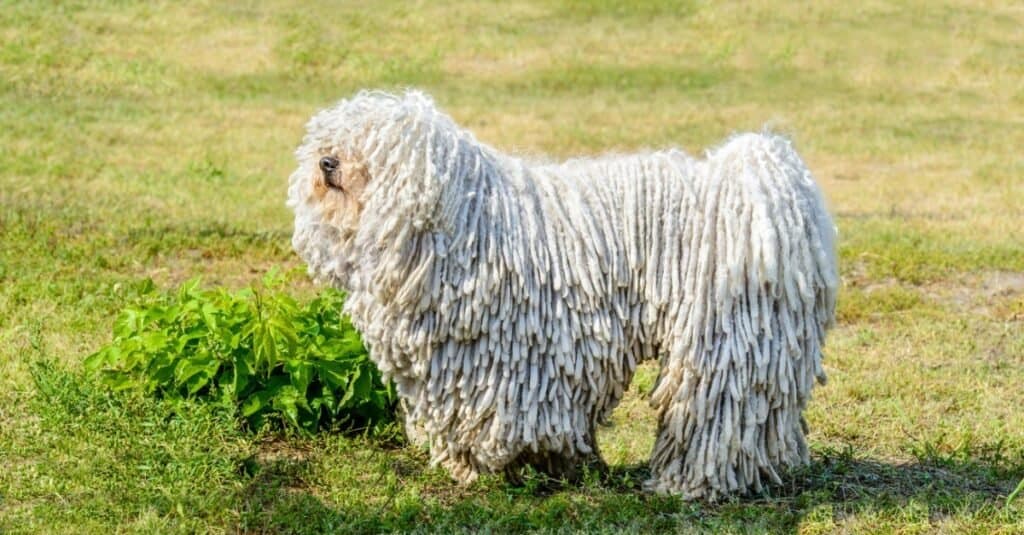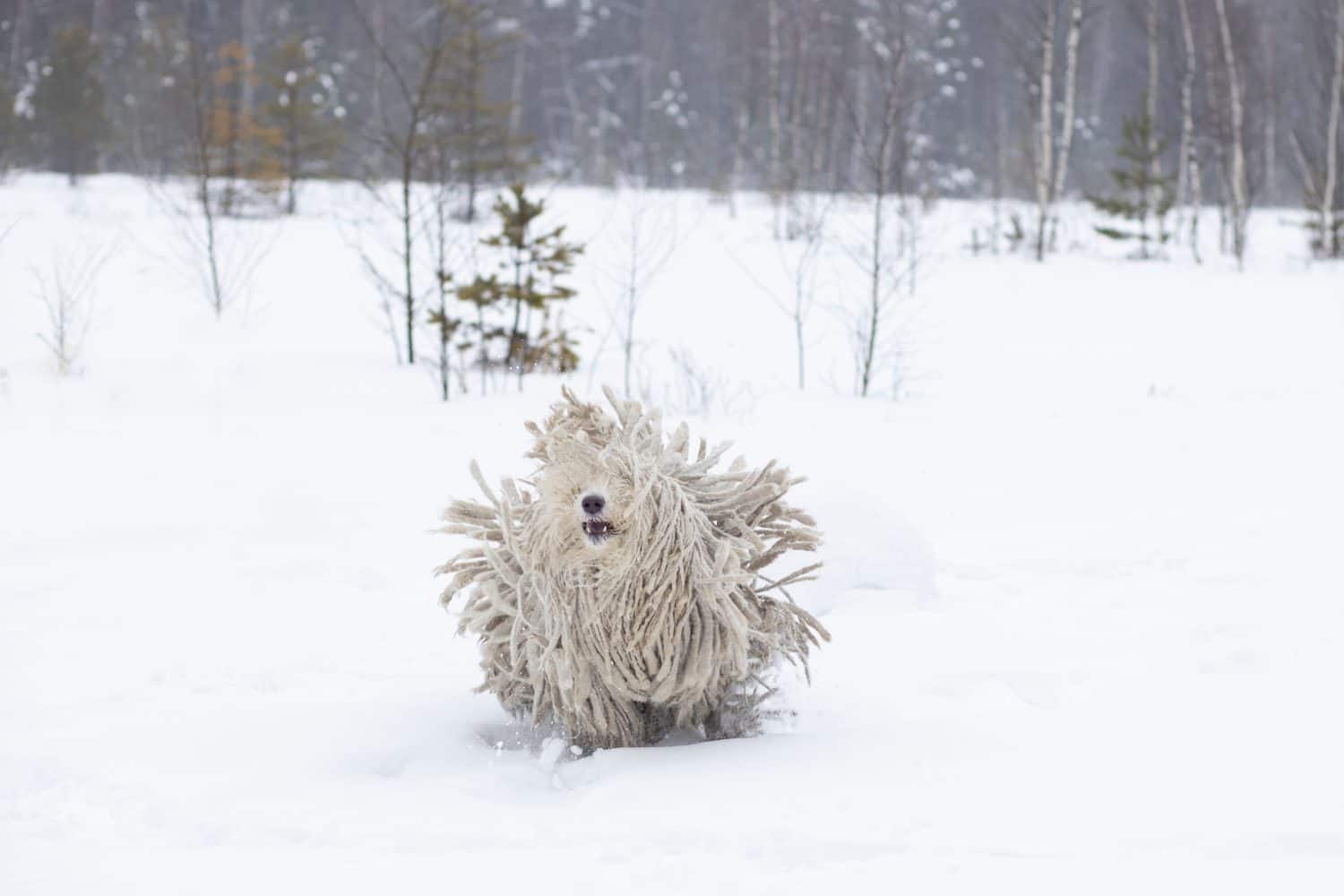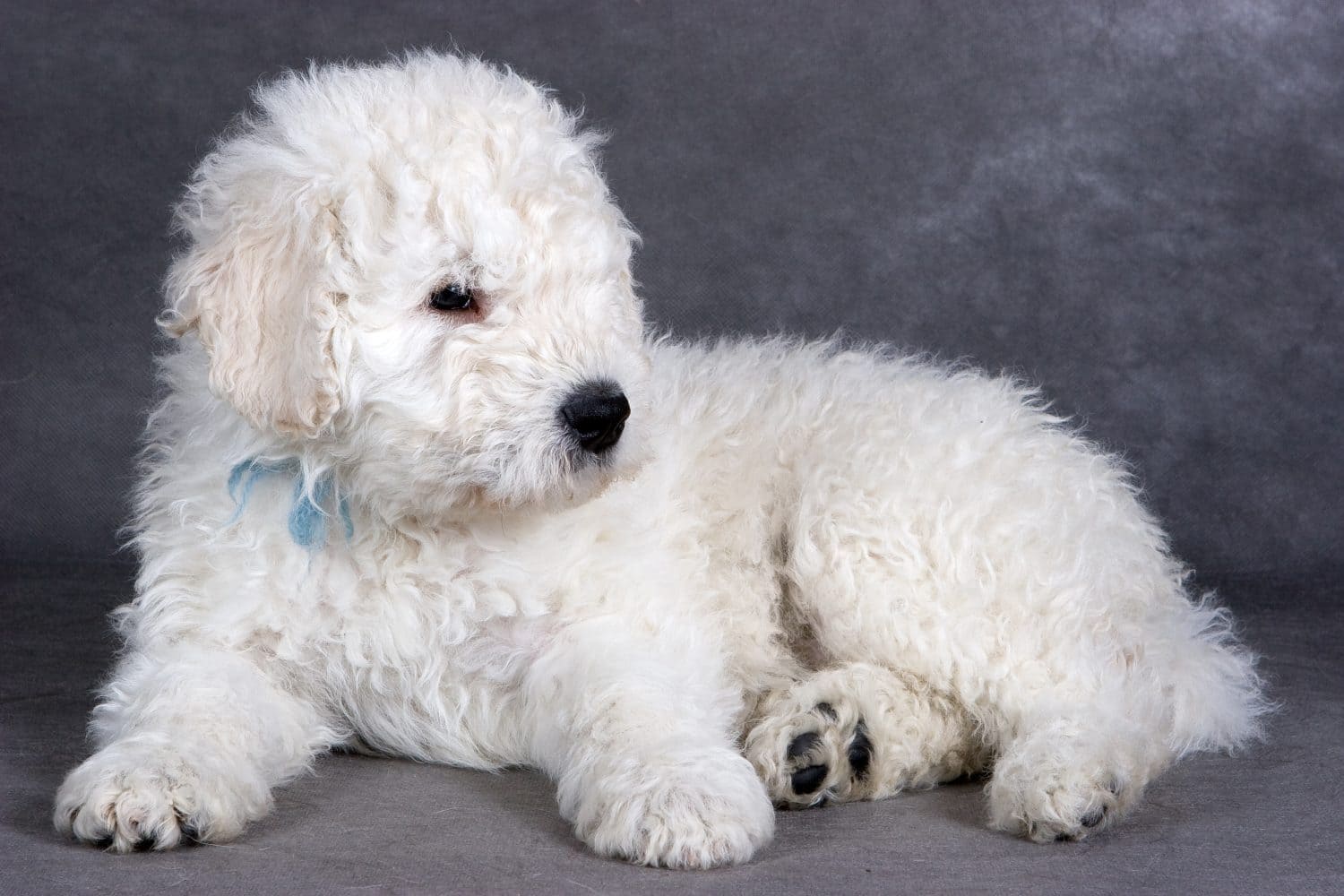If you see a Komondor and puli in separate photos, you may note the similar corded coats and little black noses peeking out from their furry faces. However, if you’re able to see them side by side, you’ll notice several differences. In this article, we’ve detailed for you the six key differences between the Komondor and puli.
Comparing the Komondor and the Puli
Both the Komondor and puli come from Hungary. They were bred to take care of livestock — one as a guardian and the other as a herding dog.
| Characteristic | Komondor | Puli |
|---|---|---|
| Size | 80 to 100+ pounds, 25.5 to 27.5 inches tall | 25 to 35 pounds, 16 to 17 inches tall |
| Color | White | Silver, white, black, cream, and brown |
| Temperament | Laid back, protective, barks a lot, difficult to train, not good with children | Quick, agile, barks a lot, easier to train, good with children |
| Health | Prone to hip dysplasia, entropion eye conditions, juvenile cataracts, and bloat Life expectancy: 10 to 12 years | Prone to hip dysplasia, progressive retinal atrophy, and deafness Life expectancy: 12 to 16 years |
| Cost | $800 to $1,500 | $1,500 to $2,500 |
| Care and Grooming | Not hypoallergenic, minimal shedding, needs frequent grooming, moderate exercise | Allergenic, minimal shedding, needs frequent grooming, needs more exercise |
Komondor vs. Puli: Differences in Size

Pulik are much smaller than Komondorok, though they may look similar in appearance.
©iStock.com/Bigandt_Photography
Komondorok (plural of Komondor) are considered large dogs. They’re part of the working dog group and were bred to protect livestock. Brought to Hungary by the Cumin people — hence the name, Komon (Cumin) dor (dog)— their large size made them more formidable-looking. Male Komondorok are typically 27.5 inches tall and weigh about 100 to 130 pounds. Females are about 25.5 inches tall and generally weigh 80 to 100 pounds.
Pulik (plural form of puli), on the other hand, are considered small to medium breeds. They belong to the herding group and are also from Hungary. Male pulik are usually 17 inches tall, while females are typically 16 inches tall. Both sexes weigh about 25 to 35 pounds.
Komondor vs. Puli: Differences in Color

Pulik come in more colors than the white Komondorok.
©BORINA OLGA/Shutterstock.com
The singular white coat of the Komondor puts it among other breeds that come in just one color. However, puppies are sometimes born with just a tad of cream or buff shading. This usually fades when they mature. Underneath their fur, Komondorok have gray skin.
Pulik can come in a variety of colors. Their coats can be rusty black, black, brown, cream, a variety of gray shades, and white — though the AKC doesn’t recognize brown or cream. Underneath their fur, their skin is fully pigmented with a gray or bluish cast.
Komondor vs. Puli: Differences in Temperament

The Komondor is a laid-back, stoic breed of dog.
©iStock.com/volofin
Bred for protecting livestock, Komondorok are laid-back and a little aloof. They’re more of the “nightshift workers,” keeping an eye out on a rather quiet shift rather than running around herding. They are, however, extremely vigilant and protective. They’ll bark every time someone comes to the door or walks into the house.
Komondorok have very little prey or food drives, so they’re difficult to bribe. This makes them more difficult to train than many other breeds. They have rated a two out of five on some intelligence scores, and they didn’t make Stanley Coren’s list of top 80 intelligent dogs.
Pulik, conversely, were bred as herding dogs. They’re agile, quick, and responsive dogs that were born to herd livestock. They, too, are vigilant and protective. If someone comes to the door or walks into the house, pulik will bark to alert their owners.
These little dogs are quite intelligent, ranking 27th on Stanley Coren’s list of intelligent breeds. Along with being intelligent, pulik want to please their owners. They are easier to train than their larger canine cousins, Komondorok.
Komondor vs. Puli: Differences in Health

Though both the Komondor and the Puli, are relatively healthy, they do have some health issues.
©vkysnoefoto/Shutterstock.com
Both the Komondor and puli are relatively healthy dogs. Yet, they do have certain issues and conditions to which they’re prone. One health concern they have in common is hip dysplasia. Be that as it may, pulik have a low-risk profile for the condition while Komondorok have a medium-risk profile.
In addition to being prone to hip dysplasia, Komondorok are also at risk for entropion — which can include inverted eyelids, an increase in tears, and eye discharge — and cataracts. Gastric dilation-volvulus, or bloat, is another potential health issue.
Pulik are less prone to hip dysplasia. They are mildly susceptible to progressive retinal atrophy, and deafness. Pulik don’t have any specific dietary requirements. Therefore, feeding your puli a high-quality nutritious diet and taking them to the vet for regular check-ups will help them live a long and healthy life.
Komondor vs. Puli: Differences in Cost

There are very few Puli breeders in the U.S.
©Dragos Asaftei/Shutterstock.com
Komondorok and pulik are rather rare breeds. There are less than 10,000 Komondorok estimated to live worldwide. Similarly, there are only 150 registered pulik each year compared with about 60,000 golden retriever pups. This is because there are so few breeders of both dog breeds.
Buying a Komondor puppy from a reputable breeder will cost you anywhere from $800 to $1,500. Pulik are even less common, so the cost is higher. You can expect to pay between $1,500 and $2,500 for a puli puppy.
Komondor vs. Puli: Differences in Care and Grooming

The Komondor puppy’s coat changes texture at around 8 to 12 months of age.
©Utekhina Anna/Shutterstock.com
Komondor puppies have soft fur that changes between 8 and 12 months when the coat becomes matted. By 16 months, they begin to get the corded coat for which they’re most notable. It’s important to understand that you need to separate the fluffy fur into cords by hand. The puppy hair mixed with the adult hair gives the dog its beautiful corded coat for life.
While washing their coats isn’t overly tedious, you need to make sure to remove all the debris it often brings in before shampooing. Drying is an arduous task, in contrast. Whether wet and dry vacuuming, cage drying, natural drying, or using another method, it takes patience and diligence. Komondorok aren’t hypoallergenic, but they shed minimally.
The puli’s coat is also fluffy as a puppy. Its adult coat comes in at around 12 months. That’s when you separate the fluff into cords by hand for up to 4 months of age. With the puppy fur corded with the adult fur, the cords are set. At about 4 years old, the coat will reach the ground.
Pulik, if they’re housepets, may only need a bath every couple of months. As long as you check their fur for any residue and regularly wash their beards and behinds, they should stay relatively clean. For both pulik and Komonodorok alike, it’s crucial to use a special dog shampoo — never human shampoo — that has been recommended by your vet.
Just like the Komondor, it’s important to make sure that your puli’s coat is completely dry. For both dog breeds, using a cool dryer setting will prevent any overheating. Pulik are hypoallergenic, and they’re minimal shedders.
Komondorok need moderate exercise, while pulik, being more active, need more exercise. Both breeds will benefit from regular vet visits, healthy diets, clean water, love, and attention. A Komondor can live 10 to 12 years with the right care. Pulik can live 12 to 16 years under optimal conditions.
| Characteristic | Komondor | Puli |
|---|---|---|
| Size | 80 to 100+ pounds, 25.5 to 27.5 inches tall | 25 to 35 pounds, 16 to 17 inches tall |
| Color | Only white | Silver, white, black, cream, and brown |
| Temperament | Laid back, protective, barksa lot, more difficult to train, not good with children | Quick, agile, barks a lot, easier to train, good with children |
| Health | Prone to hip dysplasia, entropion eye conditions, juvenile cataracts, and bloat Life expectancy: 10 to 12 years | Prone to hip dysplasia, progressive retinal atrophy, and deafness Life expectancy: 12 to 16 years |
| Cost | $800 to $1,500 for a puppy | $1,500 to $2,500 for a puppy |
| Care and Grooming | Not hypoallergenic, minimal shedding, needs frequent grooming, moderate exercise | Allergenic, minimal shedding, needs frequent grooming, needs more exercise |
The photo featured at the top of this post is © Ershov_Andrey/Shutterstock.com
Thank you for reading! Have some feedback for us? Contact the AZ Animals editorial team.






